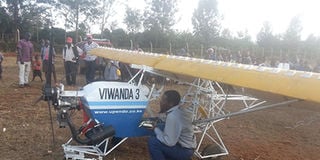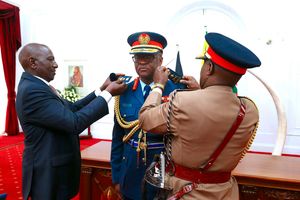Man makes his own aircraft, hopes to fly them

Gabriel Nderitu with his Viwanda 3 home-made aircraft on Wednesday October 2, 2013. PHOTO|SAMUEL KARANJA.
What you need to know:
- So far he has not been successful in having any of them fly.
- His earlier versions either crashed or were dismantled after they were found to be too heavy during test flights.
- He has never stepped inside an aeronautical engineering classroom but has trained himself using materials available on the Internet.
- Mr Nderitu terms his innovation as a very expensive venture due to the huge expenditure involved.
- An engine costs Sh350,000 while the propeller goes for Sh60,000.
He wants to be the first Kenyan to make and fly a homemade aeroplane manufactured using locally available materials.
And just like the Wright brothers, Orville and Wilbur, who are credited with inventing and building the world's first airplane in the 19th century, Gabriel Nderitu has already made11 planes.
But so far he has not been successful in having any of them fly.
However, that has not dampened his resolve to one day fly in his own aeroplane.
The IT expert from Nyeri County was on Wednesday last week fly-testing two of his three remaining planes at Kambirwa airstrip in Kiharu, Murang’a County.
He has three planes named Viwanda1, 2 and 3.
His earlier versions either crashed or were dismantled after they were found to be too heavy during test flights at Kangundo and Murang’a.
One of the aircrafts he was attempting to fly on Wednesday is manually controlled while the second one is remote controlled.
“I began this journey five years ago.
FAILED ATTMEPTS
I have spent about Sh1million attempting to fly my home made planes,” he said after the failed attempts at the dusty and parched Kambirwa airstrip.
He says he has never stepped inside an aeronautical engineering classroom but has trained himself using materials available on the Internet.
The manually controlled aircraft failed to pick speed and could not lift itself from the ground and stuck on the dusty air field.
But the remote controlled one did pick speed but crashed on two concrete poles and broke a propeller before it could fly.
A huge crowd of villagers and school children had gathered to witness the spectacle. Luckily, no one was injured in the crash.
“Today's tests were very successful compared to the ones I did here last year. We have seen a great improvement on take-off speed,” he said.
He is optimist that he is headed for success despite the crash.
Last year, the remote controlled craft did actually take off but crashed on a tree and was extensively damaged.
INVENT SOMETHING UNIQUE
Mr Nderitu said he developed a keen interest on aeronautical engineering out of curiosity and a keen desire to ‘invent something unique’.
“I want to show Kenyans that we can make our own machines and other products instead of relying entirely on foreign goods,” he says.
Mr Nderitu said the two aircrafts which he was test flying were using the same engine, alternately as it is very expensive to import such an engine. One costs Sh350,000 while the propeller goes for Sh60,000.
The other parts like wings and the entire body frame are made using locally available materials like aluminium sheets and hollow tubes.
The two planes use super petrol for fuel.
“Today I broke a propeller and I will need another Sh60,000 to replace it,” said the 45-year-old as the remote controlled plane was towed and loaded into a waiting lorry from it crash site by a team of four men he has employed.
During the past trials, Mr Nderitu says five propellers have been broken due to lack of good fields for the flying experiments.
There are no fields available for his kind of flying tests, he says.
WON'T GIVE UP
However, the self-made IT professional said he is not giving up on his venture, adding that he has seen some positive improvement.
He said the last trial in 2011 involved an aircraft which was too heavy and weighed 500 kilograms.
“The current remote controlled one is 140 kilogrammes heavy and the manual aircraft now weighs 180 kilos after we made some adjustments,” said the self-taught ‘aeronautical engineer’.
He says he is interested in industrialisation and he intends to motivate Kenyans to manufacture local products and create jobs.
However, Mr Nderitu terms his innovation as a very expensive venture due to the huge expenditure involved.
“After breaking a propeller today, am not sure if I will be able to replace it as I have completely exhausted my finances for funding this projects.
I call upon the government and interested institutions like polytechnics and colleges to partner with me,” he said.




